Here in the UK it’s that time of the year when everything seems poised, ready to spring – in both senses of the word. I haven’t been able to get across to Sherbrooke for several weeks now so I thought I’d drop in to the Edinburgh Botanic Gardens and see whether there are any signs of new life.
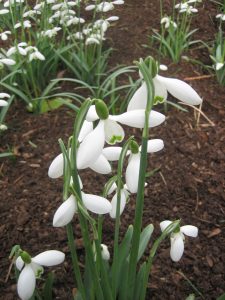
Snowdrops in the Edinburgh Botanic Gardens. Couldn’t you just eat that compost?
I wandered along my usual route, noting here a drift of snowdrops and there a swathe of creamy-green oriental hellebores. I even found an early Williamsii camellia, with a beautiful clear pink single flower, sheltering in the lea of the glasshouses. The crocuses are still at that stage where they look as if they’ve forgotten they’re supposed to have a stalk: the flowers – white, yellow, rich purple – a sprinkle of bright confetti under the trees.
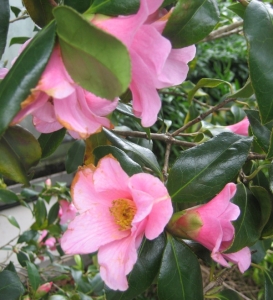
Beautiful clear-pink Camellia x williamsii ‘Bow Bells’, flowering in a sheltered spot
Then, just to the west of the rock garden, in an area that I don’t think I have really noticed in the past, I saw some intriguing construction going on. Some new raised beds are being built, but what really caught my eye was the material used for the retaining walls. It looked like large blocks of compressed compost, standing in for the stones you might have expected to see. They’re clearly very versatile: they seem to be stable up to about three blocks (approximately one metre) high, so at different heights they can retain either fairly substantial raised beds or a pattern of curved, shallow terraces.
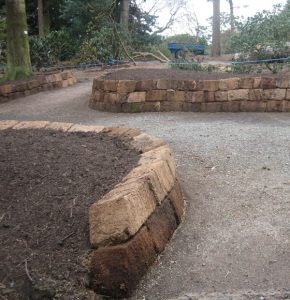
New retaining walls near the rock garden
My visit must have coincided with lunchtime because there was ne’er a ‘hort’ in sight, but a phone call when I got home explained all. The blocks are, in fact, sphagnum peat. The person I spoke to must have heard my sharp intake of breath because he quickly added that they come from a sustainable source in Scandinavia where they would otherwise be used to generate power.
The peat garden has been there since 1939 but it was in need of complete regeneration, partly because the peat block walls have to be replaced every 15 years or so, and partly because the whole area had been overtaken by a pernicious weed. So, in the sort of heroic undertaking that you can only dream of in your own garden, they have replaced all the soil and peat blocks and will be planting the entire area up from scratch with acid-loving woodland plants such as trilliums and gentians. Some of the planting will be into the walls themselves – which start off very dry but then gradually hydrate – so eventually all that will be visible is terraced banks of plants. The planting will be in drifts of 100 to 150 plants and should look marvellous – again, dream on amateur gardeners!
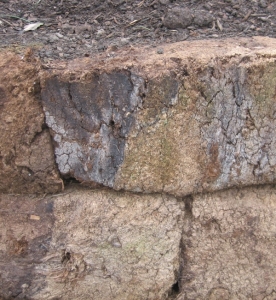
Mystery solved – the walls are made from blocks of ‘sustainable’ Swedish peat
It all started me thinking. Helen McKerral’s wonderful blog post about her “vernacular” walls has inspired me to think about trying to reconstruct some of the broken or obliterated retaining walls at Sherbrooke. We’ve got lots of stones lying around so that really might be feasible (thank you, Helen, for giving me the confidence to give it a go!).
On the other hand – or as well – maybe I could try some organic walls like those in the Edinburgh Botanics peat garden? Our moist, acid conditions would be spot on, and peat blocks would be a darned sight lighter than rocks. But we have been told repeatedly by the Royal Horticultural Society, The National Trust and the TV gardening gurus that peat cutting is unsustainable, releases greenhouse gases and is generally an environmental no-no. I’d be very surprised if importing peat from Scandinavia would come in within the budget for the Sherbrooke garden, so what to do? I idly tried googling ‘peat blocks’ and hey presto: there’s a
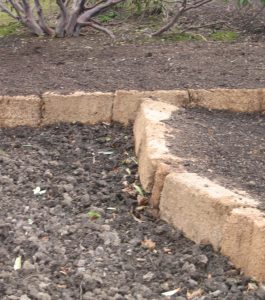
As the walls hydrate, they will become covered with acid-loving woodland plants
Scottish supplier who asserts firmly that his peat blocks are from an environmentally sustainable source. Exploring a little further, I found on the website of the famous Glendoick gardens a passionate defence of the use of sustainable peat resources, which they say should be clearly distinguished from the lowland peat bogs that have been so badly depleted. Who should I believe? And even if peat cutting is, in some situations, sustainable, what about the greenhouse gas argument? And why don’t the Scandinavians seem to bother about it? I guess I’ve got a bit more researching to do.
